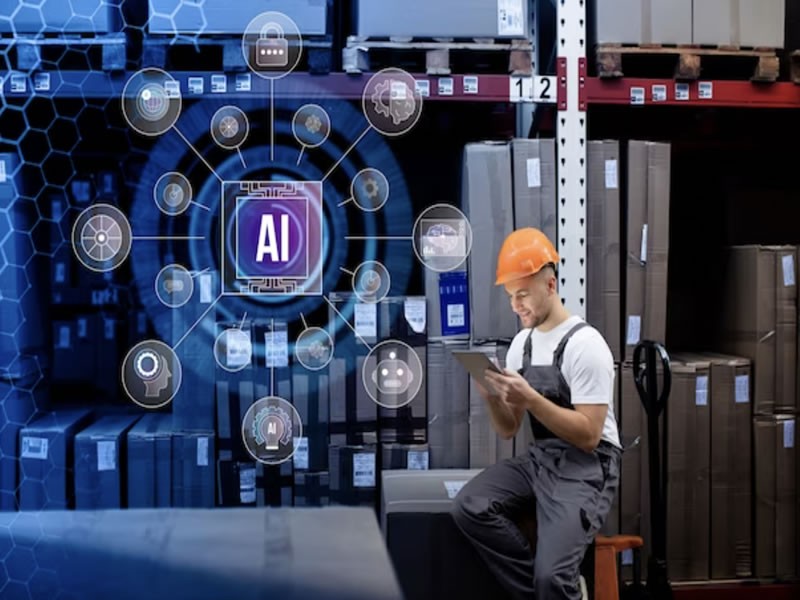Insight Blog
Agility’s perspectives on transforming the employee's experience throughout remote transformation using connected enterprise tools.
20 minutes reading time
(3928 words)
How Does AI Improve Business Efficiency? 2024 Guide
How does AI improve business efficiency? Discover business efficiency through transparency, accountability, and fairness in responsible adoption strategies.
In analyzing the question "How does AI improve business efficiency?" we go into the multifaceted ways in which artificial intelligence (AI) applications elevate productivity. As these applications evolve, their capacity to streamline operations and optimize resource allocation grows exponentially.
By automating routine tasks, AI liberates human capital, enabling personnel to focus on more stimulating endeavors. Moreover, through sophisticated algorithms, AI facilitates the detection of nuanced patterns and trends, surpassing the capabilities of conventional methodologies.
This article goes into the vast potential of AI in enhancing productivity and curbing labor expenses. Whether an entity operates on a modest scale or boasts a considerable corporate footprint, AI presents opportunities to bolster efficiency and bolster fiscal savings.
What is Artificial Intelligence?
Artificial Intelligence (AI) refers to the development of computer systems capable of performing tasks that traditionally necessitate human intelligence. These tasks encompass learning, reasoning, problem-solving, perception, language understanding, and decision-making.
The primary goal of AI is to create machines that can replicate, simulate, or even surpass human intelligence, tackling intricate problems and enhancing efficiency.There are various types of AI, with Narrow AI (or weak AI) designed for specific tasks with limited capabilities. In contrast, General AI (or strong AI) remains a theoretical concept, aiming to develop machines that can think and learn like humans, possessing consciousness and self-awareness.
Machine learning is a vital component of AI, involving the training of computers to learn and improve from experience without explicit programming. Deep learning, a subset of machine learning, entails training artificial neural networks on extensive datasets to recognize patterns and make decisions based on them.
In a world dominated by subtractive productivity, AI has emerged as a significant catalyst for change and innovation. This impact extends to various domains such as automation, robotics, natural language processing (NLP), computer vision, and autonomous driving.
Defining productivity in the workplace
Productivity is the measurement of output per input unit, typically expressed as a ratio. In the realms of business and economics, productivity serves as a crucial indicator of a company's or a country's ability to efficiently convert resources into goods and services.
This metric helps assess resource utilization effectiveness, propelling growth and ultimately elevating the standard of living.
Several key factors influence productivity:
- Human Capital: The knowledge, skills, and abilities of the workforce are paramount to productivity. A well-trained and skilled workforce operates more efficiently, contributing to higher productivity levels.
- Technology: The adoption of modern technology, including automation and software, directly impacts productivity by streamlining processes, reducing errors, and saving time. Artificial Intelligence (AI) is a significant component of modern technology and can play a pivotal role in boosting productivity.
- Management Practices: Efficient management practices, encompassing proper planning, organization, and effective communication, have a substantial impact on productivity. Strong leadership and sound decision-making result in improved resource allocation and heightened productivity.
- Infrastructure: Access to reliable and effective infrastructure, such as transportation and communication networks, enhances productivity by reducing logistical constraints and facilitating the smooth flow of goods and information.
- Innovation: Innovation propels progress, enabling businesses to create new products, services, and processes that enhance efficiency and productivity.
Integrating AI into businesses to improve productivity is a multifaceted task requiring a deep understanding of the business's processes, necessary adjustments in the workflow, and workforce training to adapt to new technologies and different productivity styles.
Nevertheless, the potential benefits of AI, including cost reduction, resource optimization, and overall manufacturing productivity growth, make the investment worthwhile.
What is AI's Impact on Productivity?
Unveiling the Fundamentals of Artificial Intelligence
Advantages of ai embodies the creation of computer systems adept at executing tasks typically reserved for human intelligence.
These encompass learning, reasoning, problem-solving, perception, language comprehension, and decision-making. The overarching goal of AI lies in fashioning machines capable of emulating, simulating, or even surpassing human intellect, thereby unraveling solutions to intricate problems and refining operational efficiency.
Diverse categories of AI exist, notably Narrow AI, also dubbed weak AI, tailored for specific tasks with constrained capabilities. Conversely, General AI, termed strong AI, remains a theoretical construct, envisioning machines that can cogitate and acquire knowledge akin to human cognition, complete with consciousness and self-awareness.
Machine learning stands as a pivotal facet of AI, whereby computers undergo training to assimilate and enhance performance through experience sans explicit programming.
Deep learning, a subset of machine learning, entails the training of artificial neural networks on extensive datasets to discern patterns and render decisions based on them. These tasks often require GPU-based software to accelerate model training and inference, making large-scale AI applications feasible in real-world scenarios.
In a contemporary landscape dominated by subtractive productivity paradigms, AI emerges as a pivotal catalyst for transformative innovation. This encompasses realms such as automation and robotics, natural language processing (NLP), computer vision, and autonomous vehicular navigation.
Deciphering Productivity and Its Critical Elements
Productivity stands as the metric measuring output generated per unit of input, commonly articulated as a ratio.
Within the realms of business and economics, productivity serves as a pivotal gauge, reflecting a company's or nation's capacity to efficiently convert resources into goods and services.
This metric not only assesses the efficacy of resource allocation but also propels growth, ultimately elevating the quality of life.
Numerous pivotal factors exert influence on productivity:
- Technology: Contemporary technological advancements, encompassing automation and software utilization, directly impact productivity by streamlining processes, mitigating errors, and economizing time. Within this technological tapestry, AI emerges as a transformative force, capable of bolstering productivity significantly.
- Human Capital: The collective knowledge, skills, and proficiencies of the workforce play a pivotal role in shaping productivity. Well-trained and adept employees exhibit heightened efficiency and effectiveness, thereby fostering elevated productivity levels.
- Management Practices: Efficient management methodologies, including meticulous planning, structured organization, and proficient communication, wield substantial influence on productivity. A robust leadership framework coupled with astute decision-making translates to optimal resource allocation and heightened productivity.
- Innovation: Innovation serves as the harbinger of progress, empowering businesses to forge novel products, services, and processes that drive efficiency and productivity enhancements.
- Infrastructure: Access to dependable and efficient infrastructure, spanning transportation and communication networks, augments productivity by alleviating logistical hurdles and facilitating the seamless exchange of goods and information.
Effectively integrating AI into business operations to enhance productivity entails a multifaceted endeavor. It necessitates a profound comprehension of existing workflows, requisite adjustments in processes, and workforce training to adeptly navigate through evolving technological landscapes.
Nevertheless, the prospective benefits of AI, including cost reduction, resource optimization, and overarching manufacturing productivity augmentation, underscore its merit as a worthwhile investment.
Follow us and access great exclusive content everyday: Follow us on Google News
Harnessing AI for Augmented Productivity
Artificial intelligence (AI) assumes growing prominence in augmenting productivity across diverse sectors.
Through harnessing the capabilities of AI-driven technologies, enterprises can rationalize workflows, heighten efficiency, and fine-tune resource allocation.
Furthermore, implementing judicious productivity strategies can yield dividends for businesses, affording them time savings and elevating the caliber of their output. This encompasses the adoption of AI-powered automation tools such as robotic process automation (RPA) and natural language processing (NLP).
These sophisticated systems excel in automating mundane tasks, thereby mitigating human errors and expediting the execution of specific activities.
1. Streamlining Through Automation and Time-Efficient Technologies
Among the foremost AI applications fostering productivity enhancement lies automation. By mechanizing repetitive and time-intensive tasks, enterprises liberate their workforce to concentrate on more pivotal facets of their roles, often involving creativity or strategic planning.
An array of tasks ripe for automation through AI technology spans data entry, invoicing, scheduling, and customer support via chatbots like chatgtp and live chat software.
Furthermore, AI-driven virtual assistants, exemplified by Google Assistant, Alexa, and Siri, offer adept assistance in myriad everyday tasks such as setting reminders or conducting information searches. This time-saving functionality extends benefits both within professional spheres and daily routines.
Adopting AI technologies for process automation not only yields significant time and cost efficiencies for businesses but also diminishes the likelihood of human errors. Consequently, this dual impact augments productivity and fortifies overall company performance.
You may also like: Best Apps for Employees: UPDATED 2022 – A Complete Guide
2. Unveiling Insights Through Data Analysis and Predictive Analytics
The integration of AI-driven data analysis and data annotation stands as a pivotal force in augmenting productivity, and empowering businesses to make informed decisions regarding resource allocation and investments.
Predictive analytics, a cornerstone of AI applications, equips companies with the capability to scrutinize vast datasets, extracting invaluable insights from discernible patterns and trends. These insights serve as guiding beacons in the decision-making realm.
Harnessing the potency of predictive analytics alongside AI tools, businesses can pinpoint potential bottlenecks and inefficiencies within their workflows. Armed with this knowledge, they embark on the journey to streamline processes, thereby amplifying productivity and operational efficiency.
3. Enhancing Communication and Collaboration Through AI Tools
Efficient communication serves as the linchpin for maximizing organizational productivity. AI-driven communication and collaboration tools emerge as indispensable aids, streamlining processes, enhancing efficiency, and curtailing time allocated to administrative tasks.
An example of AI's impact on communication tools lies in AI-powered language translation, adept at eradicating language barriers prevalent among employees operating from disparate locations or diverse cultural backgrounds.
Additionally, machine learning algorithms find integration into email platforms, where they prioritize incoming messages, empowering users to manage their inboxes with heightened efficacy.
When it comes to collaborative tools, AI fosters enhanced team workflows by tracking progress and scrutinizing performance metrics, thus fortifying collaborative endeavors and bolstering overall productivity.
Free ebook: How To Get Your Intranet Off The Ground
4. Tailoring Through Personalization and Adaptation
The integration of AI-driven personalization and adaptation heralds a paradigm shift in productivity enhancement, tailoring tools and systems to cater to individual users' unique needs and preferences. An illustrative instance lies in AI-powered adaptive learning platforms, adept at analyzing an employee's existing knowledge and preferred learning style to craft bespoke training programs.
Moreover, leveraging a knowledge base management system enables the organization of employees' accumulated knowledge, harnessing it for training endeavors. By furnishing personalized content and bespoke learning modules, employees exhibit heightened engagement, enhanced preparedness, and the capacity to optimize productivity in their roles.
Furthermore, delving into AI voiceover capabilities elevates personalized interactions to unprecedented heights, delivering seamlessly natural and dynamic audio content that resonates profoundly with customers. This capability also extends to text-to-speech functions, enriching the user experience across diverse interfaces.
Industry-Specific AI Applications
Artificial Intelligence (AI) has become increasingly integrated across diverse industries, driving process optimization, enhancing customer experiences, and fostering accelerated growth.
1. Crafting Retail and E-commerce Funnels
The AI penetration into the retail and e-commerce domain is evident, as platforms such as Shopify use AI for product descriptions while businesses use technologies driven by artificial intelligence to optimize sales funnel.
Through the use of customer behavior data, marketers apply personalized strategies such as targeted campaigns and product recommendations to increase conversion rates.
Sales funnels define the customer journey from first contact to purchase, allowing businesses to identify and eliminate potential barriers. AI-powered tools help make quick and accurate decisions on massive datasets, allowing faster decision-making with higher ROI.
Crucial to business success, funnel builder software such as BuilderAll or its equivalents have a vast library of templates that allow for the quick creation of customized and effective funnels that cater to various needs in different businesses
2. Elevating Manufacturing Productivity
With the arrival of Artificial Intelligence (AI), a new paradigm in productivity enhancement has been introduced to manufacturing that is transforming processes and enhancing output across many different operations.
The implementation of AI in manufacturing processes has resulted in a plethora of benefits, which exploit advanced technologies to simplify operations and enhance overall performance.
Several key applications underscore AI's transformative impact:
- Predictive Maintenance: Predictive maintenance programs driven by AI transform the approach to machinery upkeep through data analytics that forecast potential failures or wear on equipment. Through early identification of issues, maintenance teams can intervene before the breakdowns happen and thereby reduce downtime or repair costs.
- Robotics: AI-powered robots are essential resources in manufacturing environments increasing accuracy and effectiveness on several activities. These multi-tasking machines handle assembly, materials handling, and inspection jobs with ease. Powered by AI, robots that learn from their environments guarantee uniform quality of production while accelerating the pace along the assembly line.
- Quality Control: AI-based inspection systems are a new paradigm in quality assurance protocols, where real-time analysis is done on manufactured goods to detect defects and noncompliance with the predefined standards. Through AI automation, inspection processes minimize human errors and at the same time reduce costs associated with product reworks as well as wastes.
- Smart Manufacturing: AI enables the development of digital twins, virtual copies of physical assets, or processes that allow manufacturers to virtually simulate and predict outcomes with an accuracy never seen before. Through such digital models, firms fine-tune production lines and resource allocation to make data-driven decisions for better operational efficiency.
In essence, AI has become the foundation of modern manufacturing providing unmatched capabilities to boost productivity and product quality as well as advance industry innovation. With manufacturers progressively adopting AI-driven technologies, it becomes more and more obvious how to achieve greater efficiency and competitiveness in the global market.
3. Enhancing Efficiency in the Service Industry
The service sector, too, has embraced the advancements of AI, deploying various applications to elevate customer experiences and operational efficiency. In generative AI for customer support, AI-driven chatbots and virtual assistants engage with clients in real time, offering personalized assistance and resolving common queries promptly.
This not only enhances support response times but also enables human agents to devote attention to more complex customer issues.
For optimizing workforce management, AI algorithms utilize historical data and employee skill sets to predict customer demand patterns, thus refining scheduling and task allocation for service-oriented businesses.
For instance, AI helpdesk software intelligently routes and prioritizes inquiries, streamlining customer support processes and augmenting overall efficiency and satisfaction.
Additionally, businesses leverage Natural Language Processing (NLP) technology to comprehend and analyze customer feedback, social media mentions, and other unstructured data.
This insights-driven approach aids in understanding customer sentiment and devising targeted marketing strategies to enhance productivity and customer engagement.
4. Revolutionizing Financial Services and Banking
AI has brought about profound transformations in the financial services and banking sector, manifesting in several key areas:
- Fraud Detection and Prevention: AI-based algorithms analyze vast transactional data sets to detect fraud patterns and potential cyber threats, thereby safeguarding customer accounts and sensitive information.
- Credit Scoring: Machine learning models aid lenders in evaluating borrower creditworthiness by extracting insights from diverse data sources, including social media profiles and previous loan records. This enhances the accuracy of credit risk assessments, with tools for calculating personal loan payments becoming increasingly precise.
- Robo-advisory Services: AI-driven robo-advisors have gained traction among investors seeking to optimize their portfolios. By leveraging user data, robo-advisors offer personalized investment recommendations powered by sophisticated algorithms and market analysis.
Across industries, AI technology is harnessed to boost productivity, enhance efficiency, and generate added value for companies and consumers alike.
With ongoing advancements in AI and machine learning, the impact of these technologies on industry-specific applications is poised to deepen further.
Navigating Challenges in AI Implementation
1. Seamlessly Integrating with Existing Systems
Integrating AI solutions into existing IT infrastructure, business processes, and workflows presents a myriad of challenges for organizations to navigate. Firstly, organizations must ensure that their current systems are equipped to support AI capabilities, which may necessitate updates or upgrades to essential software, hardware, or network components.
Moreover, organizations need to assess their systems' capacity to handle the substantial volume of data required for effective AI algorithms. This could entail investments in data storage, cloud computing, and data transformation platforms. A significant hurdle lies in data integration, as AI algorithms typically draw from diverse data sources. Ensuring seamless communication among these disparate sources can be complex, time-intensive, and costly, particularly when dealing with legacy systems lacking modern data integration capabilities.
Organizations must prioritize developing a robust data strategy and architecture that facilitates effortless data integration and communication across the organization. Critical to success is ensuring that the AI integration solution aligns with the organization's overarching business objectives. This entails integrating AI solutions into existing decision-making processes, workflows, and company culture.
Achieving alignment may necessitate a shift in mindset, comprehensive training, and effective change management strategies to embed AI seamlessly into the organizational fabric.
2. Mitigating Data Privacy and Security Risks
Implementing AI solutions often entails extensive collection of personal and sensitive data, necessitating robust measures to address data privacy and security concerns responsibly and in compliance with regulations.
Organizations embarking on AI adoption should consider the following strategies:
- Firstly, adherence to relevant data protection laws and regulations, such as GDPR in Europe and HIPAA in the United States, is paramount. This may involve appointing data protection officers, conducting data protection impact assessments, and integrating privacy-by-design principles into AI solutions.
- Secondly, organizations must fortify data security measures to thwart data breaches and unauthorized access. Investments in data encryption, stringent authentication protocols, and intrusion detection systems are essential to safeguarding sensitive data while leveraging AI technology.
- Additionally, selecting a secure browser is pivotal for online security. Conducting comparisons, such as Chrome vs Safari or Brave vs Chrome, enables informed decisions tailored to specific security priorities.
Transparency and effective communication play pivotal roles in addressing data privacy and security concerns. Organizations must clearly communicate data collection practices and usage in AI solutions to stakeholders, including employees, clients, and customers. This includes outlining measures undertaken to protect sensitive information throughout its lifecycle.
3. Workforce Dynamics and Implications
The widespread integration of AI solutions carries significant implications for the workforce, presenting a spectrum of potential outcomes, both advantageous and challenging. While AI promises heightened productivity and economic expansion, it also brings forth concerns regarding job displacement, labor market upheaval, and the imperative for skill evolution.
Proactively addressing these workforce implications commences with a candid evaluation of roles and tasks susceptible to automation within the organization. Armed with this insight, organizations can embark on investment endeavors in retraining and upskilling initiatives, facilitating employees' adaptation and transition into new roles.
Central to this endeavor is the cultivation of transferable skills encompassing critical thinking, problem-solving, effective communication, and emotional intelligence.
Collaboration with educational institutions, governmental bodies, and community-based organizations is paramount in establishing a robust talent pipeline and championing reskilling endeavors.
Furthermore, fostering a culture of continual learning and professional development is essential. This may entail offering internal and external training modules, mentorship programs, and diverse resources to nurture employees' growth and career advancement.
Advantages and disadvantages of artificial intelligence in business
Every technological progress comes with its own set of advantages and disadvantages. The ongoing discourse surrounding AI delves into the extensive benefits and potential drawbacks at various levels. Beyond the sensational headlines that either sensationalize or instill fear, what exactly does AI accomplish?
The benefits encompass a wide spectrum, including the streamlining of processes, time-saving measures, elimination of biases, and automation of repetitive tasks, among others. On the flip side, the drawbacks include the substantial costs associated with implementation, the possibility of human job displacement, and the inherent limitations in terms of emotional intelligence and creativity.Here are some more some more advantages and disadvantages of artificial intelligence in business:
Advantages of Artificial Intelligence in Business
- Enhanced Efficiency and Productivity: One of the key advantages of integrating artificial intelligence (AI) into business operations is the significant improvement in efficiency and productivity. AI systems can automate repetitive tasks, allowing employees to focus on more complex and strategic activities. This leads to streamlined processes, faster decision-making, and ultimately, increased output.
- Data Analysis and Insights: AI excels at processing and analyzing vast amounts of data in real-time. Businesses can harness this capability to gain valuable insights into customer behavior, market trends, and operational performance. The ability to make data-driven decisions can give companies a competitive edge, helping them adapt to changing market conditions and customer preferences.
- Cost Savings: Implementing AI technologies can lead to substantial cost savings for businesses. Automation reduces the need for manual labor in routine tasks, cutting down on operational expenses. Additionally, AI-powered systems can identify inefficiencies, optimize resource allocation, and prevent costly errors, contributing to overall financial efficiency.
- Personalized Customer Experiences: AI enables businesses to deliver highly personalized customer experiences. Through machine learning algorithms, companies can analyze customer data to understand preferences and behaviors, tailoring products and services to individual needs. This personalized approach not only enhances customer satisfaction but also fosters customer loyalty.
- Innovative Products and Services: AI opens up new possibilities for innovation in product development and service delivery. Businesses can create innovative solutions, such as chatbots, virtual assistants, and predictive analytics, to better meet customer needs. This adaptability and innovation can position a company as an industry leader, driving long-term success.
Disadvantages of Artificial Intelligence in Business
- High Initial Costs: Implementing AI systems can involve significant upfront costs, including the purchase of hardware, software, and the hiring of skilled professionals. For smaller businesses with limited financial resources, these initial expenses can be a barrier to entry.
- Job Displacement and Workforce Challenges: The automation of tasks through AI can lead to job displacement for certain roles, particularly those involving repetitive and routine activities. While AI may create new job opportunities, there is a risk of a skills gap, as the workforce needs to adapt to new technologies and acquire more specialized skills.
- Data Privacy and Security Concerns: The extensive use of AI in business involves the collection and analysis of vast amounts of sensitive data. This raises concerns about data privacy and security. Businesses must implement robust cybersecurity measures to protect against potential breaches and unauthorized access to valuable information.
- Lack of Emotional Intelligence: While AI systems excel in processing and analyzing data, they lack the emotional intelligence and understanding that human interactions often require. This can be a drawback in customer service and other areas where empathy and nuanced understanding are crucial.
- Dependency and Reliability Issues: Businesses relying heavily on AI systems may face challenges when these systems encounter technical glitches or malfunctions. Dependence on AI without adequate contingency plans can lead to disruptions in operations and negatively impact customer experiences. Ensuring the reliability and resilience of AI systems is crucial to mitigating these risks.
Wrapping up
The widespread integration of AI solutions carries significant implications for the workforce, presenting a spectrum of potential outcomes, both advantageous and challenging. While AI promises heightened productivity and economic expansion, it also brings forth concerns regarding job displacement, labor market upheaval, and the imperative for skill evolution.
Proactively addressing these workforce implications commences with a candid evaluation of roles and tasks susceptible to automation within the organization. Armed with this insight, organizations can embark on investment endeavors in retraining and upskilling initiatives, facilitating employees' adaptation and transition into new roles.
Central to this endeavor is the cultivation of transferable skills encompassing critical thinking, problem-solving, effective communication, and emotional intelligence.
Collaboration with educational institutions, governmental bodies, and community-based organizations is paramount in establishing a robust talent pipeline and championing reskilling endeavors. Furthermore, fostering a culture of continual learning and professional development is essential. This may entail offering internal and external training modules, mentorship programs, and diverse resources to nurture employees' growth and career advancement.
Categories
Blog
(2569)
Business Management
(314)
Employee Engagement
(204)
Digital Transformation
(171)
Intranets
(119)
Growth
(114)
Remote Work
(61)
Sales
(48)
Collaboration
(37)
Culture
(29)
Project management
(29)
Customer Experience
(25)
Knowledge Management
(21)
Leadership
(20)
Comparisons
(5)
Ready to learn more? 👍
One platform to optimize, manage and track all of your teams. Your new digital workplace is a click away. 🚀
Free for 14 days, no credit card required.















